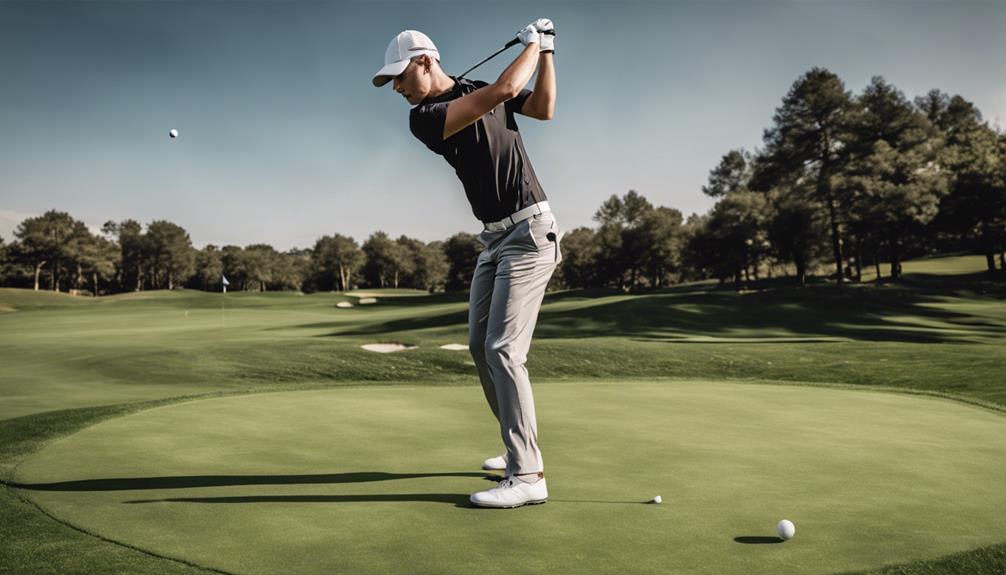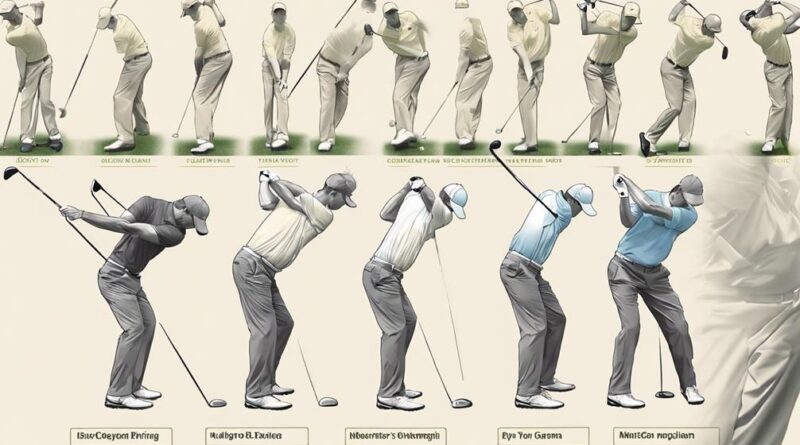Why Is Biomechanics Essential for Golf Players?
Understanding biomechanics is crucial for golfers seeking peak performance. It fine-tunes your swing efficiency by analyzing hip rotation, wrist angles, and spinal position. Identifying areas for enhancement is key. Plus, it diminishes injury risks. Delve deeper into the mechanics for optimized play.
Benefits of Biomechanics in Golf
Understanding the biomechanics of your golf swing can significantly enhance your performance on the course. By delving into the intricacies of how your body moves during a swing, you can unlock a plethora of benefits that range from injury prevention to performance enhancement. A key aspect that biomechanics addresses is swing efficiency, which plays a crucial role in the overall success of your game.
Biomechanical analysis allows you to dissect the different components of your swing, such as the rotation of your hips, the angle of your wrists, and the position of your spine. By breaking down these movements, you can identify areas of improvement that can lead to a more efficient and powerful swing. This optimization not only enhances your performance by increasing the distance and accuracy of your shots but also reduces the risk of injuries caused by poor mechanics.
Injury prevention is a significant advantage of understanding the biomechanics of your golf swing. Through proper analysis, you can identify movements or positions that put strain on your body, increasing the likelihood of injuries. By making adjustments based on biomechanical principles, you can ensure that your swing not only improves your performance but also safeguards your body from unnecessary stress.
Understanding Golf Swing Mechanics
To comprehend the intricate mechanics of a golf swing, one must focus on the precise coordination of body movements and club dynamics. Understanding the golf swing mechanics involves a detailed analysis of swing patterns, muscle activation, and the interaction between the golfer's body and the club.
Here are five key points to consider:
- Swing Analysis: Conduct a thorough analysis of your swing to identify areas for improvement and optimize performance.
- Muscle Activation: Understand how different muscles are activated during the swing sequence to generate power and control the club.
- Club Path: Analyze the path of the clubhead throughout the swing to ensure proper alignment and ball contact.
- Timing and Rhythm: Focus on the timing and rhythm of your swing to achieve consistency and accuracy in your shots.
- Impact Dynamics: Study the impact dynamics between the clubface and the ball to maximize distance and precision.
Importance of Body Alignment in Golf
Analyzing body alignment in golf is crucial for optimizing performance and enhancing shot accuracy and consistency. Proper posture correction plays a fundamental role in ensuring that your body is in the optimal position to execute a successful swing. By aligning your body correctly, you can improve swing efficiency, allowing for a smoother and more controlled motion throughout the swing.
Maintaining balance stability during the golf swing is essential for achieving impact control. Your body alignment directly influences how stable you're during the swing, affecting your ability to strike the ball cleanly and accurately. When your body is aligned correctly, you can distribute your weight evenly, leading to better stability and control over the club.
Moreover, body alignment impacts your ability to control the impact of the club on the ball. A well-aligned body position enables you to transfer energy effectively from your body to the club, ensuring that you generate the desired impact on the ball. This control over impact is crucial for achieving consistent and accurate shots on the golf course.
Enhancing Power and Distance
Enhancing power and distance in your golf game requires a keen focus on biomechanical efficiency and coordinated muscle engagement. To achieve this, consider the following key factors:
- Hip Rotation: Maximizing hip rotation allows for increased coil and torque, translating into more power and distance in your swing.
- Shoulder Alignment: Proper alignment of the shoulders optimizes the swing plane, enhancing accuracy and distance.
- Weight Shift: A controlled weight shift from backswing to downswing is crucial for generating power and distance.
- Wrist Hinge: Utilizing the correct wrist hinge technique can add leverage to your swing, boosting both accuracy and distance.
- Foot Positioning: Ensuring correct foot positioning helps in maintaining balance and stability throughout the swing, leading to increased power and distance.
Preventing Injuries Through Biomechanics
Reducing the risk of injuries in golf through biomechanical analysis and corrective techniques is imperative for maintaining peak performance and longevity in your game. Injury prevention is a critical aspect of any golfer's training regimen, and biomechanics techniques play a crucial role in achieving this goal.
Biomechanics can help identify potential areas of weakness or vulnerability in your golf swing that may predispose you to injuries. Through advanced motion analysis, experts can pinpoint faulty movement patterns, excessive stresses on certain joints, or imbalances in muscle activation that could lead to chronic issues over time. By addressing these biomechanical inefficiencies, you can proactively prevent injuries before they occur.
Furthermore, biomechanics techniques can be utilized to implement corrective exercises and drills tailored to your specific movement patterns and physical limitations. These targeted interventions aim to improve your body mechanics, enhance your functional strength, and optimize your overall movement efficiency, reducing the strain on vulnerable areas of your body during the golf swing.
Achieving Consistency in Golf Shots
To achieve consistency in your golf shots, mastering fundamental biomechanical principles is essential. Achieving accuracy and muscle control in your shots requires a deep understanding of the biomechanics involved. Here are five key factors to consider:
- Shot Accuracy: Understanding how your body position, alignment, and posture influence the direction and precision of your shots is crucial. Biomechanics can help you optimize these factors for better accuracy.
- Muscle Control: Proper muscle activation and coordination play a significant role in achieving consistent shots. Biomechanical analysis can help you identify areas of muscle weakness or imbalance that may be affecting your performance.
- Swing Mechanics: Analyzing your swing mechanics through a biomechanical lens can provide insights into how forces are generated and transferred throughout the swing. Adjusting your mechanics based on this analysis can lead to more consistent shots.
- Balance Training: Maintaining balance throughout your swing is essential for consistency. Biomechanics can help you understand how weight shift, center of gravity, and stability impact your balance and provide guidance on improving these aspects.
- Consistent Kinetic Chain: A well-coordinated kinetic chain is key to consistent shots. Biomechanics can help you optimize the sequencing of movements from the ground up, ensuring efficient energy transfer and shot consistency.
Impact of Club Dynamics on Performance

Understanding the intricate dynamics of the golf club and how they impact your performance is crucial for optimizing your game. When it comes to swing analysis, the club dynamics play a significant role in determining the outcome of your shot. The weight distribution of the club, the angle of the clubface at impact, and the shaft flex all influence how the club interacts with the ball. By analyzing these factors, you can make adjustments to your swing to achieve more consistent and accurate shots.
Equipment optimization is another key aspect influenced by club dynamics. The design of the club, including the materials used, the clubhead size, and the grip type, can all affect how the club performs during your swing. For example, a club with a larger sweet spot may be more forgiving on mishits, while a club with a lower center of gravity can help launch the ball higher and with less spin. By understanding how these factors interact with your swing, you can choose the right equipment to suit your playing style and maximize your performance on the course.
Improving Overall Golf Game Through Biomechanics
Improving your overall golf game through biomechanics involves analyzing and optimizing your body's movements to enhance performance and consistency on the course. By focusing on key areas such as strength training and flexibility exercises, you can make significant strides in your game.
- Strength Training: Engaging in specific exercises to build muscle strength can improve your swing power and overall performance on the course.
- Flexibility Exercises: Incorporating stretches and mobility drills can enhance your range of motion, allowing for a more fluid and efficient golf swing.
- Biomechanical Analysis: Utilizing technology to assess your movements can pinpoint areas for improvement and help tailor your training program accordingly.
- Balance and Stability Work: Enhancing your balance and stability through targeted exercises can lead to more controlled and precise shots.
- Customized Training Programs: Working with a biomechanics expert to create a personalized training plan based on your unique body mechanics can optimize your golf game.
Frequently Asked Questions
How Can Biomechanics Improve a Golfer's Mental Game?
When it comes to improving your mental game in golf, biomechanics plays a crucial role.
By incorporating visualization techniques, you can enhance your focus and performance on the course.
Additionally, utilizing breathing exercises can help alleviate performance anxiety and promote a sense of calmness during crucial moments.
These biomechanical strategies not only improve your physical game but also strengthen your mental resilience on the golf course.
What Role Does Nutrition Play in Golf Biomechanics?
Proper nutrition impacts golf biomechanics by fueling your body for optimal performance. Nutrients like carbohydrates provide energy for those power swings, while proteins aid in muscle recovery and growth.
Hydration is crucial for joint lubrication and overall function. By maintaining a balanced diet, you enhance your physical capabilities, leading to improved biomechanics on the golf course and ultimately enhancing your performance.
Are There Specific Biomechanics Drills for Putting?
When practicing putting, focus on body alignment and posture to optimize your performance.
Specific biomechanics drills can target muscle activation and stability essential for a consistent stroke.
Incorporate exercises that enhance core strength and balance, such as stability ball drills or single-leg stance exercises.
Can Biomechanics Help With Golf Course Management?
Biomechanics can revolutionize your golf game by enhancing swing analysis for improved performance and injury prevention. Through biomechanical assessments, you can optimize your techniques and develop strategies that align with the demands of different golf courses.
Understanding how your body moves and reacts during play can lead to more effective course management decisions, ultimately elevating your overall performance on the green.
How Does Age Affect the Application of Biomechanics in Golf?
As you age, the application of biomechanics in golf may face some limitations due to changes in physical conditioning. Aging golfers often experience reduced flexibility, strength, and coordination, impacting their swing mechanics.
Biomechanics can help address these issues by providing tailored strategies to optimize performance while considering age-related changes in the body.
Understanding how age influences biomechanics in golf is crucial for developing effective training programs for older players.
Conclusion
In conclusion, biomechanics is essential for golf players as it allows for a deeper understanding of the body's movements during a swing, leading to improved alignment, power, and consistency in shots.
By analyzing club dynamics and preventing injuries through proper biomechanical techniques, golfers can enhance their overall game performance.
Utilizing biomechanics in golf not only enhances player performance, but also helps in preventing injuries and achieving greater success on the course.
